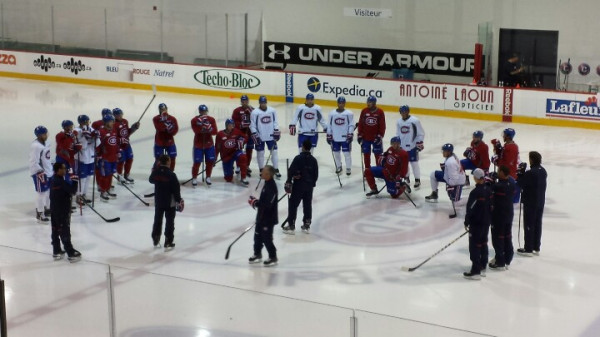By Steve Farnham, Associate Editor, AllHabs.net
LONGUEUIL, QC. — For the upcoming NHL season, I’ve decided to take a journey to the dark side of the numbers world of hockey, and by that I mean that I will be providing readers here at All Habs with an in-depth look at advanced statistics, and how they apply to the Montreal Canadiens lineup.
I call it the dark side because many people still aren’t convinced of the relevance of advanced statistics in isolation and whether they truly have any meaning at all. Others, the “galactic empire” we shall call them, believe that numbers, any numbers, are the end-all and be-all and can completely replace observational hockey analysis. The truth may lie somewhere in between that certain statistics, when interpreted correctly and in context can assist in measuring a player’s effectiveness, and can be a more accurate predictor of player trends.
For a long time, I was undecided on the subject myself. Are advanced statistics truly worth my time, and of course yours? I decided to take the time to research and broaden my understanding on the subject and share my findings with you.
It started with reading, a lot of reading. Countless hours scanning through articles on advanced statistics, and comparing spreadsheets in an attempt to get a grasp on the subject. Back in June, guest writer Rob Vollman authored an article at All Habs where he explained which advanced statistics a team should be keeping an eye on when signing players during the free-agent season. In this article, he mentioned that “(…) advanced statistics tend to just make everything more confusing.” The comment was interesting coming from a man who was promoting his own flavour of advanced statistics, but I can partly agree that coming to understand the subject for me, was at times quite confusing.
The pieces of the puzzle started falling into place for me when a friend, Andrew Berkshire, gave me a call about the subject. After a discussion with Andrew I now feel more confident that I can analyse and interpret these statistics — and perhaps help others to formulate a more credible opinion on the matter.
For our first lesson, let’s jump right in as we take a look at some advanced statistics, compiled for current Montreal Canadiens’ players during their respective 2011-12 seasons.
Montreal Canadiens – Advanced Statistics for 2011-12
| NAME | POS | GP | TOI/60 | Corsi Relative |
Corsi |
On-Ice Sh% |
On-Ice Sv% |
PDO |
| AARON PALUSHAJ | RW | 38 | 7.5 | 20 | 13.68 | 6.06 | 939 | 1000 |
| ANDREI MARKOV | D | 13 | 12.75 | 15 | 0 | 7.5 | 909 | 984 |
| MAX PACIORETTY | LW | 79 | 14.46 | 12.3 | 4.73 | 10.24 | 902 | 1005 |
| ERIK COLE | RW | 82 | 14.51 | 12 | 4.18 | 10.03 | 914 | 1014 |
| SCOTT GOMEZ | C | 38 | 11.39 | 9.4 | 6.93 | 6.57 | 903 | 969 |
| P.K. SUBBAN | D | 81 | 17.22 | 6.3 | -0.17 | 9.83 | 920 | 1018 |
| FREDERIC ST-DENIS | D | 17 | 11.97 | 5.4 | -0.59 | 9.2 | 933 | 1025 |
| DAVID DESHARNAIS | C | 81 | 13.94 | 3.8 | -1.33 | 10.39 | 919 | 1023 |
| MATHIEU DARCHE | LW | 61 | 9.72 | 1.3 | -1.01 | 4.96 | 921 | 970 |
| BRIAN GIONTA | RW | 31 | 13.85 | 0.7 | 1.4 | 9.9 | 894 | 993 |
| ALEXEI YEMELIN | D | 67 | 15.22 | -0.1 | -3.94 | 7.4 | 897 | 971 |
| ANDREAS ENGQVIST | C | 12 | 5.55 | -0.2 | -0.9 | 3.57 | 933 | 969 |
| TOMAS KABERLE | D | 72 | 13.3 | -0.6 | -5.2 | 8.46 | 909 | 994 |
| LARS ELLER | LW | 79 | 12.58 | -0.8 | -4.83 | 7.23 | 916 | 988 |
| LOUIS LEBLANC | C | 42 | 10.64 | -1.1 | -9.81 | 8.79 | 939 | 1027 |
| JOSH GORGES | D | 82 | 17.3 | -1.3 | -4.91 | 9.33 | 920 | 1014 |
| CHRIS CAMPOLI | D | 43 | 13.85 | -2.4 | -9.07 | 8.63 | 919 | 1005 |
| TOMAS PLEKANEC | C | 81 | 13.49 | -3.8 | -6.53 | 8.4 | 903 | 987 |
| RAPHAEL DIAZ | D | 59 | 14.44 | -3.9 | -4.08 | 6.68 | 927 | 993 |
| RENE BOURQUE | LW | 76 | 13.08 | -5.9 | -10.08 | 7.64 | 907 | 984 |
| BLAKE GEOFFRION | LW | 35 | 10.02 | -6.4 | -12.66 | 6.4 | 955 | 1019 |
| PETTERI NOKELAINEN | RW | 56 | 7.25 | -7 | -10.2 | 5.73 | 912 | 969 |
| YANNICK WEBER | D | 60 | 11.4 | -9.2 | -10.62 | 7.48 | 926 | 1000 |
| BRAD STAUBITZ | LW | 62 | 6.5 | -9.8 | -20.99 | 4.39 | 947 | 990 |
| RYAN WHITE | C | 20 | 12.14 | -11.7 | -19.27 | 4.12 | 927 | 968 |
| MICHAEL BLUNDEN | RW | 39 | 8.99 | -12.6 | -16.78 | 6.72 | 942 | 1009 |
| TRAVIS MOEN | LW | 48 | 13.05 | -13.7 | -11.21 | 8.94 | 916 | 1006 |
| NAME | Penalties Taken/60 |
Penalties Drawn/60 |
Off Zone Start % |
Off Zone Finish % |
Corsi Rel QoC |
Corsi QoC |
Corsi Rel QoT |
| AARON PALUSHAJ | 0.8 | 2.1 | 48.5 | 51.2 | -0.241 | -1.917 | -0.732 |
| ANDREI MARKOV | 0 | 0.7 | 55.3 | 53.7 | -0.172 | -0.765 | 0.87 |
| MAX PACIORETTY | 0.6 | 1 | 49.4 | 55.6 | 0.068 | -0.204 | 2.539 |
| ERIK COLE | 1 | 1.3 | 51.5 | 53.5 | 0.005 | -0.017 | 2.332 |
| SCOTT GOMEZ | 0.7 | 0.7 | 63.8 | 57.8 | -0.129 | -0.82 | -1.49 |
| P.K. SUBBAN | 1.2 | 0.9 | 46.3 | 50 | 1.266 | 0.903 | 0.416 |
| FREDERIC ST-DENIS | 1.2 | 0 | 52.5 | 46.8 | -0.807 | -1.231 | 0.234 |
| DAVID DESHARNAIS | 0.4 | 0.8 | 52.2 | 55.5 | 0.042 | 0.007 | 4.116 |
| MATHIEU DARCHE | 0.4 | 1.2 | 51.6 | 48.9 | -0.459 | 0.131 | -1.666 |
| BRIAN GIONTA | 0.8 | 1 | 43.9 | 47.3 | 0.752 | 0.912 | -0.763 |
| ALEXEI YEMELIN | 0.8 | 1.2 | 47.5 | 51.5 | -0.107 | -0.184 | 0.754 |
| ANDREAS ENGQVIST | 1.8 | 0 | 59.1 | 52 | -0.707 | -0.264 | -1.08 |
| TOMAS KABERLE | 0.3 | 0 | 53.1 | 50.2 | -0.581 | -0.561 | 1.162 |
| LARS ELLER | 1.3 | 0.8 | 48.3 | 50.9 | 0.57 | 0.429 | -1.306 |
| LOUIS LEBLANC | 1.2 | 0.4 | 48.5 | 52.9 | -0.123 | 0.09 | -0.854 |
| JOSH GORGES | 0.6 | 0.3 | 44.5 | 50.3 | 1.411 | 1.068 | 1.704 |
| CHRIS CAMPOLI | 0.3 | 0.8 | 48.3 | 52.6 | -0.229 | -0.494 | 0.624 |
| TOMAS PLEKANEC | 1.3 | 0.5 | 42.8 | 44.5 | 0.905 | 0.727 | -0.629 |
| RAPHAEL DIAZ | 1 | 0.2 | 47.3 | 50.8 | 0.101 | 0.598 | 0.312 |
| RENE BOURQUE | 1 | 0.4 | 47.6 | 47.7 | 0.693 | 0.088 | -1.034 |
| BLAKE GEOFFRION | 1.2 | 0.7 | 40.8 | 46.5 | -0.157 | -1.587 | -1.809 |
| PETTERI NOKELAINEN | 0.7 | 0.6 | 41.7 | 49.2 | -1.055 | -0.021 | -0.125 |
| YANNICK WEBER | 1 | 0.2 | 56.5 | 52.6 | -0.789 | -0.717 | 0.788 |
| BRAD STAUBITZ | 1.8 | 1.6 | 44.8 | 46.9 | -0.998 | -1.014 | -1.552 |
| RYAN WHITE | 1 | 1.5 | 40 | 53.1 | 1.304 | 0.59 | -0.859 |
| MICHAEL BLUNDEN | 0.5 | 0.3 | 38.2 | 47.6 | -0.18 | 0.97 | -1.186 |
| TRAVIS MOEN | 0.7 | 0.7 | 43.8 | 45.1 | 0.793 | 1.615 | -0.496 |
– Mouse-over column headers for descriptions
– Filtered to a minimum of ten games played during the season (2011-12), and ordered by Relative Corsi
There’s quite a bit of information here and you can easily feel overwhelmed by it all. It’s important to look at each statistic one at a time, but even more important to then take a step back, and look at the entire picture, and see how the statistics compare with one another. Only then do the numbers start to make sense.
On first glance, two items immediately come to attention.
- Why does Aaron Palushaj appear at the top of the list in Corsi and Relative Corsi?
- Brad Staubitz has quite a few minuses over multiple columns, and this must explain why Andrew rages like the blitzkrieg whenever his name is mentioned.
Before I even begin to try to explain that, let me simply define Corsi and Relative Corsi.
Corsi Relative Corsi
- Corsi is a more advanced approach of looking at a player’s +/- differential.
- Rather than basing the statistic uniquely on goals like +/- does, Corsi measures a player’s +/- based on all shots, whether they end up being a goal, are stopped by the goalie, blocked before reaching the net, miss the net or hit the post.
- The idea is that in all of these situations, you are engaging your opponent in their defensive end, and that’s a positive for your team. The statistic is measured on a per 60 minute rate.
- Relative Corsi is simply the difference between the player’s Corsi, and the team’s Corsi when he’s not on the ice.
- That would lead you to believe that a player with a positive Relative Corsi is a player who your team would suffer without, while in the opposite scenario, players with a negative Relative Corsi are players who your team could do without.
- That’s not always the case as we will see
As a general rule, just remember that anytime you see “relative” in the label of a statistic, it means that it’s comparing the statistic of the player, to that of his team, while that same player is not on the ice.
Let’s go back to Aaron Palushaj who last season had a team-leading Relative Corsi of +20.0. “But why?” were my exact words to Andrew. He went on to explain to me his interpretation of the numbers that bring us to this high Relative Corsi for Palushaj.
In a nutshell, Relative Corsi is a measure that cannot be looked at alone (like most statistics) and other statistics also have to be taken into consideration. As we look at the other statistics, the picture becomes a little more clear as to why Aaron Palushaj’s Relative Corsi is so high.
Penalties Drawn/60 Minutes Vs. Penalties Taken/60 Minutes
If you look at Palushaj’s penalties taken per 60 minutes, he’s at 0.8 minutes per game and falls middle of the pack in the Canadiens’ roster. However, if you factor in his penalties drawn per 60 minutes of 2.1 minutes per game, he’s at positive differential of 1.3 minutes per game, much higher than any other player on the team. In other words, Palushaj receives 0.8 minutes of penalty per game, but causes his opponents to take 2.1 minutes of penalty per game, the difference being 1.3 minutes.
Mathieu Darche was second in this category with a positive differential of 0.8 minutes, followed by Andrei Markov with 0.7 minutes, while Andreas Engqvist and Frederic St-Denis were at the opposite end with a negative differential of 1.8 and 1.2 respectively.
The following statistic is where things get a little bit tricky because there’s quite a lot of debate with regards to which of two is ultimately more meaningful.
Quality of Competition (QoC) Relative Quality of Competition
- This measures the average Corsi of the opponents that the player faces while on the ice. A player with a positive QoC faces tougher competition than a player with a negative QoC.
- This measures the average Relative Corsi of the opponents that the player faces while on the ice. Just like regular QoC, positive is better, but which of these two statistics ultimately is more meaningful is still up for debate.
No matter which of the two statistics is ultimately more meaningful, Palushaj ranks 20th on the team in Relative Quality of Competition, and very last in Quality of Competition. What this means is Aaron Palushaj is only really put out on the ice to face the fourth lines of opposing teams, and his competition is fairly weak compared to that of his teammates.
At the opposite end of this category, players like Travis Moen, Josh Gorges, P.K. Subban, Tomas Plekanec and even Ryan White had to face the toughest competition of anyone else on the team.
In Travis Moen’s case, this would strongly explain why Moen ended with a terrible Corsi rating, meaning that he was put out there in situations last season that were over his head. Travis Moen is a fourth line player, third line at best, and had no business being put out there on the first line and on the powerplay last season. He’s a grinder who gets you faceoffs in the opposing zone, and provides the occasional grit, nothing more.
So to conclude the evaluation of Aaron Palushaj, I’ll offer the following:
- He had one of the lowest average minutes per game played on the team, playing only 7.5 minutes per game.
- He had the best penalties drawn vs. penalties taken differential on the team.
- He faced weaker opposition than the majority of his teammates.
- Other teams didn’t score very often when he was on the ice, having a save percentage of 0.939 per cent.
If you’re a fan of Aaron Palushaj, which I’m sure is possible, you would argue that he was a great defensive player that the team should have utilized more, while if you’re not a fan, you would argue the exact opposite, that the fact he played low minutes protected him in a way, and boosted his stats. I for one would be more inclined to believe the latter, based on the many games I’ve seen him play.
I also mentioned Brad Staubitz earlier in the piece. Here’s the reason he appears to have a low Corsi score:
- He doesn’t play many minutes per game.
- Although his on-ice save percentage is good, his on-ice shooting percentage is terrible, giving him a PDO below 1000.
- He takes more penalties per game than he draws.
- The majority of his shifts finish in his defensive zone, meaning he runs a lot in his own end.
- He faced what could be considered weak competition while on the ice.
Let’s touch on shooting percentage and save percentage for skaters.
On-Ice Shooting Percentage On-Ice Save Percentage
- This represents the team’s shooting percentage while the said player is on the ice.
- This represents the team’s save percentage while the said player is on the ice.
With respect to on-ice shooting percentage, David Desharnais, Max Pacioretty and Erik Cole had the highest percentages on the team while Engqvist, White and Staubitz with the Rangers had the lowest.
Looking at on-ice save percentage, players that are employed in defensive-minded roles rank highest, and we have Blake Geoffrion, Brad Staubitz, Michael Blunden and Aaron Palushaj at the top, while Brian Gionta, Alexei Emelin and Max Pacioretty scored the lowest.
It appears to me that there’s a correlation between on-ice save percentage and total ice-time, where players who receive the most ice-time generally appear to rank lowest, while those who receive little ice-time (often employed defensively) rank the highest. If I’m correct, it’s impressive that P.K. Subban finished the season at 0.920 per cent, a player who is often criticized for errors leading to goals for the opposing team.
PDO
- PDO is the sum of On-Ice Shooting Percentage and On-Ice Save Percentage while the said player was on the ice. It’s often referred to as a luck statistic that will always gravitate back to 1000 in the long-term.
- What this means is that a player who finishes the season with a PDO above 1000 should be expected to score lower in upcoming seasons, while in the opposite case, those who score lower than 1000 should be expected to score higher in upcoming seasons.
The luck statistic results give us Louis Leblanc, Frederic St-Denis and David Desharnais at the top, with an honorable mention to Subban who’s not too far behind. On the flip-side, Ryan White, Scott Gomez and Petteri Nokelainen scored the lowest.
I’m not sure how meaningful this statistic is other than support the argument that David Desharnais will have a negative season in 2012-13.
Offensive Zone Start Percentage Offensive Zone Finish Percentage
- This is the percentage of plays which started in the offensive zone, while the said player was on the ice.
- Calculated by dividing total offensive zone starts by total starts.
- This is the percentage of plays which finished in the offensive zone, while the said player was on the ice.
Looking at offensive zone start percentage, Scott Gomez, Yannick Weber and Tomas Kaberle scored the highest, while Michael Blunden, Ryan White and Blake Geoffrion scored the lowest. Players with a high offensive zone start percentage will mostly tend to be the offensive-minded players on the team, while players with the lower percentages are usually the players employed in defensive roles.
In measuring offensive zone finish percentage, Scott Gomez, Max Pacioretty and David Desharnais scored highest, while Tomas Plekanec, Travis Moen and Blake Geoffrion scored lowest. That’s right, the Plekanec scored lowest on the team with 44.5 per cent, but his supporters would argue that his quality of teammates is to blame. You can expect offensive zone finish percentage to gravitate around 50 per cent. Players are rarely able to maintain an above or below 50 per cent average over multiple seasons.
Corsi Relative Quality of Teammates
- This is the average relative Corsi of the teammates of the player while they are on the ice together.
A high result in this category means that the player is lined up with better players on the team, while those with a lower score tend to play with weaker players on the team.
David Desharnais had the best score by far in this category, followed by Max Pacioretty and Erik Cole, while Blake Geoffrion, Mathieu Darche and Brad Staubitz scored lowest. Those who support Tomas Plekanec will tell you that one of the reasons he didn’t produce as much as he could have last season, was very much because of this category, which shows that the quality of teammates that were playing with him on the ice was average at best last season.
If you’re as interested in goaltending as I am, you’ll be disappointed to know that, I’ve found no meaningful advanced statistics on goaltending, other than maybe even-strength save percentage. We’ll look at this in a future article.
So far, all we’ve done is scratched the surface but I hope you enjoyed this. You are welcome to leave your feedback in the comments section. I intend to look at some of these categories a little more closely in the future, and very likely others.
For his help and advocacy on advanced statistics, I recommend you follow @AndrewBerkshire. @Camcharron, managing editor of The Leafs Nation site, is also worth a follow and is one of the better writers out there right now using advanced statistics.
Follow Steve on Twitter here: @stevofarnham
(Statistics: behindthenet.ca)








![Prospect Report: Habs Development Camp Testing [GALLERY]](https://habshockeyreport.com/wp-content/uploads/2014/07/IMG_2897.jpg)

![Habs Western Road Trip in Pictures [GALLERY]](https://habshockeyreport.com/wp-content/uploads/2014/03/476898185_slide.jpg)
Comments are closed.